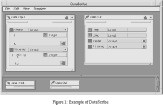4.4.2 Tools for importing data
Explorer provides a number of tools for importing data.
Standard IRIS Explorer Datatype Readers: There are a set of modules which are capable of reading standard Explorer data types from files, one for Pyramids, Lattices and Geometry. They are capable of reading data saved in either ascii or binary format.
Basic Ascii Format to Explorer Format: There are several modules which take files in simple ASCII formats and produce lattices. For example, the module ReadXData creates a 1D lattice from the data in an ascii file in the following format: n, x1, f(x1), x2, f(x2),... xn, f(xn), where n is the total number of data pairs. These modules are all written using DataScribe (see below).
DataScribe: This is IRIS Explorer's visual programming interface for creating modules to read data in a variety of user-defined formats. It takes ASCII or binary data files and outputs lattices (or vice versa). An example from DataScribe is shown in figure 9
. Some of the features of DataScribe are: 


 [Top]
[Top]

 [Top]
[Top]